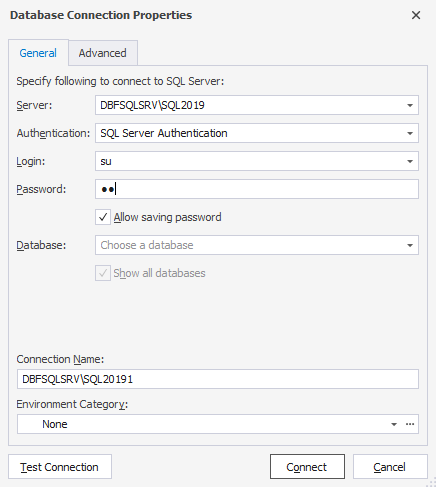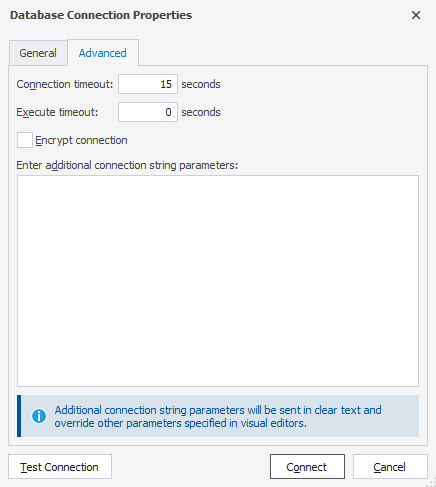Connecting to a database
Before you connect to a database, you need to create a server connection.
To create a connection
1. On the Database menu, click New Connection. The Database Connection Properties dialog opens.

2. In the Server box, select the server you want to connect to.
Note
To connect to a SQL Server using a custom port, specify the server name followed by a comma and the custom port number. For example, localhost,62005.
3. Select the Authentication type from the drop-down list.
- Windows Authentication
- SQL Server Authentication
- Active Directory - Universal with MFA authentication
- Azure Active Directory - Password
- Azure Active Directory - Integrated
For more information, see How to connect with Azure Active Directory authentication.
4. In the Login and Password boxes, enter the login credentials. By default, the password is saved automatically. If you don’t want to save the password, clear the Allow saving password checkbox.
5. In the Database box, Enter the name of a SQL database you want to connect to or select the database from the drop-down list.
6. In the Connection Name box, the connection name is automatically generated from the host name. If you want to create a distinctive name for the connection, type the new name.
7. Optional: In the Environment Category box, assign a document category to the new connection.
8. Optional: Switch to the Advanced tab to configure additional connection properties.
- Connection timeout: Set the amount of time (in seconds) during which the server should wait to establish a connection. The default value is 15 seconds.
- Execute timeout: Set the amount of time (in seconds) during which the task should be completed. The default value is 0 seconds.
- Encrypt connection: Select the checkbox if you want to use the encrypted connection.
- Enter additional string connection parameters: Set additional connection properties to the connection string.

9. Optional: To verify the connection, click Test Connection.
10. To create the connection, click Connect.
Note
If you set up a connection in one of the following tools, it will be automatically added to other dbForge SQL Tools:
- dbForge Data Compare for SQL Server
- dbForge Data Generator for SQL Server
- dbForge Schema Compare for SQL Server
- dbForge Documenter for SQL Server
- dbForge Data Generator for SQL Server
- dbForge Event Profiler for SQL Server
You can migrate connections and assigned categories between dbForge SQL tools (for example, from dbForge Data Compare for SQL Server to dbForge Data Generator for SQL Server). To do that, you should create an export settings file with the help of Import and Export Settings Wizard in one tool and then import it in another dbForge SQL tool. For more information, see Import and export settings.
Windows connection coloring
Window connection coloring allows you immediately to know which server you’re connected to. You can add coloring for each server connection in the Environment Category field of the Database Connection Properties dialog when setting the database connection properties. You will find more information regarding the coloring for servers and databases in Associating tabs with connections.
Delete a database connection
To delete a database connection, in Database Explorer, right-click the connection you want to delete and select Delete.